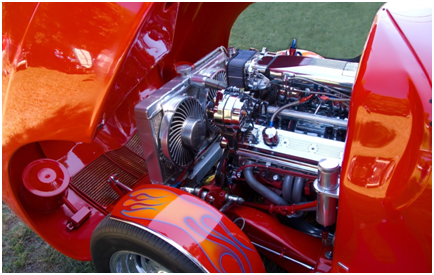So You Want to Fix Up a Classic Car?
 There’s just something about a classic car. Maybe it’s the fond memories that some people have of cruising the open roads of America as a child, nestled safely in the back seat while surrounded by two tons of prime American steel. Maybe it’s the sleek designs and carefully crafted engines brimming with horsepower that attract car lovers. Whatever it is, classic American cars are experiencing a resurgence, and more and more home mechanics are buying these fixer-uppers and carefully restoring them.
There’s just something about a classic car. Maybe it’s the fond memories that some people have of cruising the open roads of America as a child, nestled safely in the back seat while surrounded by two tons of prime American steel. Maybe it’s the sleek designs and carefully crafted engines brimming with horsepower that attract car lovers. Whatever it is, classic American cars are experiencing a resurgence, and more and more home mechanics are buying these fixer-uppers and carefully restoring them.
For many it’s the lure of turning a profit. Some restored classics can bring tens of thousands of dollars when they’re put up for sale, and this means big business for those who can purchase a rundown model and restore it properly. For others it’s simply the desire to put one’s skills to use, and to have a beautiful classic car in the garage that turns heads when she’s taken out for a spin.
Whether you’re interested in flipping cars or would like a showpiece for your driveway, there are a few things that you should know before you head down that restoration road.
What Constitutes a Classic?
Ask car collectors what constitutes a classic car and you might get a few different answers. However, the Classic Car Club of America has one of the best definitions. According to their website the Classic Car Club of America defines a classic as a fine or distinctive automobile, American or foreign built, produced between 1925 and 1948.
Before you begin to worry that your 1965 Mustang doesn’t qualify as a classic, just know that most states have a different view. A car that is at least 20 years old and is not a reproduction, but has been maintained in or restored to its original, manufacturer’s speculations is considered an antique car for the purposes of vehicle registration.
At the end of the day, the term “classic car” is really defined in the eye of the money holder.
Which Models Hold the Best Resale Value?
A 1978 Datsun might be labeled as a classic for registration purposes, but it’s abundantly clear that a 1978 Pontiac Trans Am is going to be the better choice if your goal is to sell it for a profit. There are several models that collectors are eager to get their hands on, so if you can find one of these you could be sitting on a gold mine.
- 1969 Mercury Cougar. This car was built to look similar to the Mustang, but it has a larger backseat which appealed to families at the time of its release. The Cougars came with a V8 engine, and the parts are easily obtained, especially since Mustang engine components can be used.
- 1968 Pontiac Tempest. The less expensive cousin to the incomparable GTO, the Tempest bodies were built in a slightly different manner. Because so many collectors focus on the GTO, the Tempest can be purchased quite inexpensively and parts are widely available.
- 1965 Chevrolet Impala. Sticking with the 1960s theme, it can be hard to go wrong with the Chevy Impala. Redesigned in 1965, the Impala was the first and only car to boast more than one million sales in the United States. This is good news for the collector or restoration mechanic as parts can be found without too much trouble.
How to Start a Restoration
Once you’ve secured your vehicle it’s time to map out a plan for the restoration. If you’re an experienced mechanic who has tackled a classic car before, then you’re likely in good shape. If this is your first time, you should approach the project carefully and methodically and sourcing your parts is the best place to start.
Salvage yards are excellent resources when you’re looking for old or rare parts. Whether you’re looking for a front quarter panel or a stock ashtray, a salvage yard can be a genuine treasure trove. Many salvage yards will have inventory lists published on their websites, but it can also be extremely worthwhile to just show up and browse.
Additionally, many salvage owners and employees are restoration enthusiasts themselves, and can be extremely knowledgeable about your particular model of classic car. They may also be able to give you tips on part selection and installation, and can help you find parts that they may not currently have in stock.
Restoring a classic car is a huge project and will generally involve months or years of hard work, but most refer to it as a labor of love. If you’d like to try your hand at restoration, follow some of these tips to get started, and get ready to reap the rewards of your hard work.
Category: Car Lease







I have recently sold my Chevrolet Impala and I got decent value for my classic car. I was very reluctant to sell that car but due to some financial constraints I took the decision. Thanks for sharing these wonderful tips.